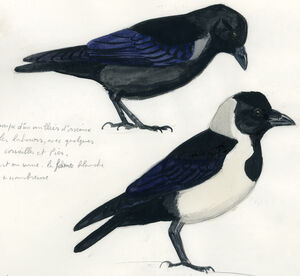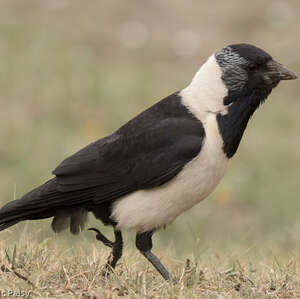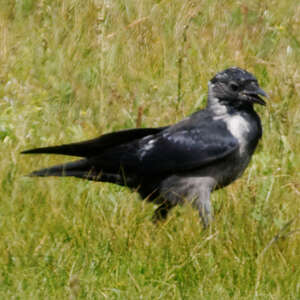Daurian Jackdaw
Coloeus dauuricus - Choucas de Daourie
Identification
Also called the Daurian Jackdaw, the Daurian Jackdaw is part of the corvid family. Its name comes from the Dauria region to the east of Russia. It is the same size, or slightly smaller, than the Carrion Crow. Its proportions and habits are also the same. However, it differs in its plumage. Many adults (but not all) have a creamy white chest, belly and nape. The white of the nape joins that of the chest forming a wide collar. The head, back, throat, wings, tail, ventral and under-tail are shiny black. A tinged gray area is visible at the back of the eye. Adults entirely black and juveniles are distinguished from the Carrion Crow by the black color of their iris (the Carrion Crow has a light gray iris).
The collared crow is the only other corvid species, sharing the same territory, which is bicolor, but its much larger size makes confusion with the Daurian Jackdaw unlikely.
Subspecific information monotypic species
Foreign names
- Choucas de Daourie,
- Grajilla oriental,
- gralha-dáurica,
- Elsterdohle,
- örvös csóka,
- Daurische Kauw,
- Taccola della Dauria,
- klippkaja,
- Mongolkaie,
- kavka strakatá,
- kavka východní,
- Sibirisk Allike,
- idännaakka,
- gralla oriental,
- Hringkráka,
- kawka srokata,
- Daurijas kovārnis,
- stepska kavka,
- Даурская галка,
- コクマルガラス,
- 达乌里寒鸦,
- klippkaja,
- 達烏里寒鴉〔東方寒鴉〕,
Voice song and call
Habitat
Behaviour character trait
Dietfeeding habits
Reproduction nesting
The Daurian Jackdaw is a cave-dweller. It nests in the crevices, which are well hidden, of trees or in the cavities of cliffs and ruined buildings.
Its very basic nest consists of a pile of twigs, grasses, horse hair, wool, feathers, and various materials taken from human activities. The two parents help with its construction. The nesting period occurs between April and June. The female lays 3 to 7 eggs which look just like those of the Carrion Crow. Incubation lasts between 16 and 18 days and the two parents take part in the feeding. The young ones take flight after a month.Geographic range
Threats - protection
IUCN conservation status
concern
in the Wild
threatened
evaluated
The Convention of Berne, Annexe III, protection of the Daurian Jackdaw (Choucas de Daourie).
Sources of information
- IOC World Bird List (v15.1), Gill, F and D Donsker (Eds). 2025-12-07.
- CROWS and JAYS, MADGE Steve
- Avibase, Lepage Denis
Other sources of interest
 Specification sheet created on
03/08/2023 by Jean-Pierre Trouillas
Specification sheet created on
03/08/2023 by Jean-Pierre TrouillasTranslation by AI Oiseaux.net
© 1996-2025 Oiseaux.net
- Accipitriformes
- Aegotheliformes
- Anseriformes
- Apodiformes
- Apterygiformes
- Bucerotiformes
- Caprimulgiformes
- Cariamiformes
- Casuariiformes
- Charadriiformes
- Ciconiiformes
- Coliiformes
- Columbiformes
- Coraciiformes
- Cuculiformes
- Eurypygiformes
- Falconiformes
- Galliformes
- Gaviiformes
- Gruiformes
- Leptosomiformes
- Mesitornithiformes
- Musophagiformes
- Nyctibiiformes
- Opisthocomiformes
- Otidiformes
- Passeriformes
- Pelecaniformes
- Phaethontiformes
- Phoenicopteriformes
- Piciformes
- Podargiformes
- Podicipediformes
- Procellariiformes
- Psittaciformes
- Pterocliformes
- Rheiformes
- Sphenisciformes
- Steatornithiformes
- Strigiformes
- Struthioniformes
- Suliformes
- Tinamiformes
- Trogoniformes















